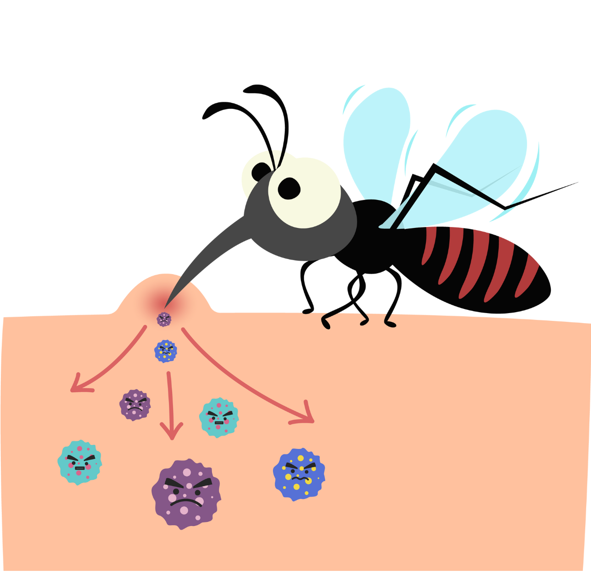Understanding Dengue: Myths, Facts, and Prevention - A Complete Guide
3/18/20244 min read


Dengue, often misunderstood and sensationalized, is a viral illness that, despite its alarming appearance, is mostly self-limiting and manageable if caught early. However, the over-exaggeration of its severity in the media and public discourse often causes unnecessary panic, which detracts from the actual focus—prevention and early intervention. In this article, we’ll provide a professional, fact-based perspective on dengue fever, address common misconceptions, and offer prevention tips to protect yourself and your community.
Dengue: The Truth Behind the Fear
Dengue fever is caused by a virus transmitted by the Aedes mosquitoes. While the disease is widespread in tropical and subtropical regions, including Southeast Asia, Africa, and the Caribbean, it is often viewed with unnecessary alarm due to sensational media coverage. A fine line exists between raising awareness and inducing panic, and unfortunately, discussions surrounding dengue often cross this line, resulting in misinformation and confusion.
The Role of Healthcare Providers:
It’s important to note that healthcare providers, especially doctors in primary and secondary care settings, cannot be held responsible for infrastructural shortcomings such as limited hospital beds, inadequate sanitation, or lack of proper waste disposal. Civic bodies should be held accountable for diseases related to poor sanitation and unsafe drinking water—dengue being one of the primary examples. Doctors can only provide treatment and manage cases, but prevention is a collective responsibility.
Understanding Dengue’s Impact
Currently, 2.5 billion people (about 40% of the world’s population) are at risk of contracting dengue. The disease is endemic in at least 100 countries across Asia, the Pacific, the Americas, Africa, and the Caribbean. According to the World Health Organization (WHO), there are an estimated 50 to 100 million dengue infections annually, which include 500,000 severe cases and approximately 22,000 deaths, mostly among children.
Key Dengue Statistics
Risk of Infection: Approximately 40% of the global population lives in dengue-prone areas.
Risk of Serious Dengue: Only about 0.5% of those infected develop a severe form of the disease.
Fatality Rate: The death rate due to dengue is relatively low at around 0.022% (220 deaths per million cases).
While every life lost is significant, the actual threat of death from dengue remains quite low, especially when compared to other diseases with higher mortality rates. However, the goal is to reduce this number through early detection, proper treatment, and preventive measures.
Dengue Symptoms: Recognizing the Red Flags
The symptoms of dengue can be deceptive and may resemble other viral illnesses, making clinical diagnosis challenging. Here are the common signs to watch for:
Initial Symptoms:
High fever
Severe back pain (commonly referred to as “back-breaking fever”)
Pain behind the eyes
Rash
Progressive Symptoms in Severe Cases:
Vomiting
Abdominal pain
Reduced urine output
Bleeding (nosebleeds, gum bleeding)
Altered alertness or confusion
Serious Dengue (Dengue Hemorrhagic Fever):
In severe forms, fluid leakage from the small blood vessels (capillaries) can occur, leading to a significant drop in blood pressure, shock, and other complications.
The Platelet Obsession: A Misconception
One of the most common misconceptions about dengue is the obsession with platelet counts. While platelet reduction is often highlighted, it is not the primary concern in dengue management. Platelets are only required in a very small number of severe cases. In fact, unnecessary platelet transfusions can cause more harm than good in certain situations. The focus should be on fluid management, monitoring urine output, blood pressure, and hemoglobin levels.
Managing Dengue: The Right Approach
If you or someone you know is suspected of having dengue, here’s how to manage it properly:
Stay Hydrated: The most important aspect of dengue care is maintaining proper hydration. Drink plenty of fluids, including oral rehydration solution (ORS).
Monitor Symptoms: Keep track of urine output, and if you notice any alarming symptoms, such as sudden abdominal pain, difficulty breathing, or excessive bleeding, seek medical help immediately.
Avoid Overfocusing on Platelet Numbers: Don’t fixate on platelet count. If the numbers aren’t dangerously low, platelets are unlikely to be the main issue.
Consult a Doctor: Always consult a healthcare provider for a proper diagnosis and guidance.
Prevention: The Key to Controlling Dengue
Since there is no specific vaccine or antiviral medication for dengue, prevention remains the most effective strategy. Here are the best ways to protect yourself:
Eliminate Mosquito Breeding Sites:
Remove standing water around your home, including in containers, flower vases, pet water bowls, and discarded tires.
Clean water containers regularly to prevent mosquito larvae from breeding.
Use Mosquito Repellents:
Apply a repellent containing 20-30% DEET to exposed skin and clothing to reduce mosquito bites.
Wear long sleeves and pants when outdoors to minimize exposure.
Ensure windows and doors are securely screened to prevent mosquitoes from entering your home.
Environmental Controls:
If possible, use air conditioning or fans to keep mosquitoes at bay.
Ensure that your home and neighborhood are clean, well-maintained, and free of mosquito breeding grounds.
Travel Precautions:
If traveling to dengue-endemic regions, ensure that your accommodation has air conditioning and screened windows and doors. The risk of dengue transmission increases in areas with poor mosquito control.
Conclusion: The Need for Rational Awareness
While dengue remains a significant health concern, especially in tropical regions, it is crucial to approach the disease with calm and rationality rather than succumbing to panic and sensationalism. Awareness should focus on prevention, recognizing early warning signs, and seeking timely medical intervention. It's also vital to discard the myth that platelet count is the primary indicator of severity, as fluid management is far more important in severe cases.
By educating ourselves and others, and by practicing preventive measures, we can collectively reduce the impact of dengue and ensure better outcomes for those affected.
EKTA INSTITUE OF CHILD HEALTH
Shankar Nagar Road,
Near Ram Mandir, New Shanti Nagar,
Raipur, Chhattisgarh - 492001
Ekta Institute of Child Health – a unit of Sparkle Hospital Pvt Ltd
